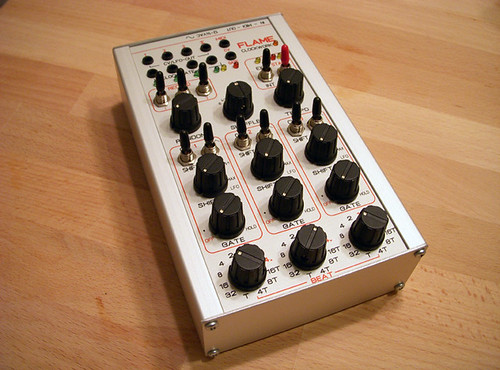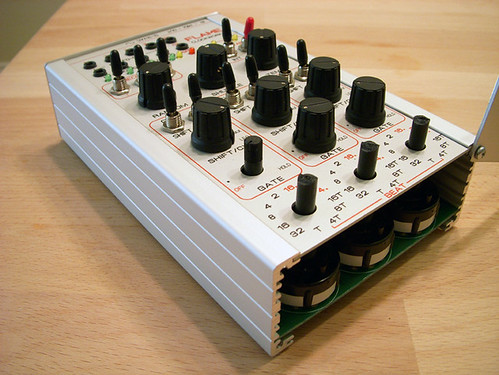
Well its been almost 24 hours since I unboxed the unit and have spent a fair amount of time using it today. I'll restate again for the sake of continuity that it was easy to grasp the units functionality without referring to the provided (see: scant) information. But I really can't blame them for that, there isn't that much to the thing honestly.
First and foremost let me get out of the way the few critical points I have on the unit, all cosmetic mind you. 1) I give you Exibit A: The bottom 3 potentiometers are different than the rest as they are 12-position switches as opposed the the full turn pots that lay throughout the rest of the unit. They also reside on a separate PCB below the PCB populated by the rest of the aforementioned pots. The posts were longer originally so they were shorted, which I can understand the reason why (who wants longer knobs hanging around short knobs? anyone, anyone? *crickets*) But the way in which they were shortened is strange to me. as shown in Exibit A they look as if they were gnawed off by rodents. I know this is a cosmetic particular and probably wholly without merit, but it was something i thought needed pointing out. 2) I did not take pictures of the power supply but the unit i received came using 230v european power with a rather fitting european power plug. Now the astute germans were kind enough to send along a power

stepper than allows us here in the states to run the lovely thing, but man, could you have used a bigger step up converter? I now know what to bludgeon any would-be intruders with if the occasion ever arose.
OK, now on to the good stuff.
I'm not a musician, I'm a drummer (ha, beat you all to it), and as such I tend to instinctually think in measurements of time rather than notes, chords, scales, what-have-you. A lot of my modular programming is based on creating intricate time driven triggers that fire off in interesting patterns to make up what eventually spills out of the VCAs and into Logic. This piece of gear has made that endeavor much more playable (and in sync to boot!) letting me quickly try out different rhythmic mixtures and variations without a lot of re-setting and re-patching. Everyone will use a particular module or unit in their own way eventually, I'm not saying my way is the best, I'm only going to tell you how I've started using it myself and take from it what you will.
BEAT: The three independent hearts of the unit. They can uniformly pulse together as one just as easily as they can dance around one another, its really all up to you. I find it very useful how the Clockwork only changes the time division on the next measure. Allowing for more common place transitions as well as helping you know where the 1 is if your not looking at the unit. (Coincidentally, the unit has two clock LEDs above the "start/stop" switch a yellow LED that flashes every quarter beat and a red LED that flashes on the down beat) Although it would be nice to have a switch or multi position knob that lets your set when the change happens (whole measure, quarter note, etc. as you can in LIVE with loops for instance. next time perhaps?)
GATE: More or less a length knob that determines the length of the impulse each track generates. When fully to the left you get nothing, nada, ziltch. At the "dot" you start to get a trigger, from then until just before the "hold" notation the further you turn the knob to the right the longer the gate is held within the time frame of the clock division. Finally, at hold its basically self explanatory.
SHIFT/CV: This is a dual function knob, dependent upon the position of the above-left switch for each shift/cv knob. In CV mode the knob is used as an attenuation for the voltage of a trigger signal up until you get past the MAX notation, once the knob reaches the LFO notation the cv outputs an LFO (duh, get on the with it) who's cycle time is synced to the set subdivision of the BEAT knob. In SHIFT mode the knob is null and void at the halfway point, any variance to the left or right shifts the timing of the gate up to half a step ahead or behind the currently selected BEAT.
Thats all I have on the FLAME Clockwork for now. I'll be stitching together a (hopefully) decent video showing its features later on in the week. For now you can view the rest of the images I took while opening it up here.
I'd recommend this unit to anyone seeking a more hands on & immediate control source for timing in your modular system, SO MUCH FUN!


3 comments:
Excellent review! I appreciate your pointing the little cosmetic details to. OCs everywhere applaud you :D
I too prefer creating more rhythmic oriented patches with the modular instead of pitch oriented and the Clockwork had caught my eye early on, and you've pretty much sold me on it. Thanks for a great review.
I'm curious though, it seems that it can also function as a MIDI-CV converter for pitch as well? Have you explored that at all yet?
Thank you :)
I have indeed tried the built in midi-to-cv converter & is works well over the 5 octaves it reads. Also, the LFO/CV outs (when the knobs aren't fully to the right) output voltages to change pitch in time with their respective gates. using the summed CV/LFO output allows you to make little melodies, etc.
This could be used to create midi-synced patterns on Moog pedals, correct? I've seen clips on Youtube from the company, but would like to see more. I know some things about basic midi, but not a lot about midi-cv conversion and how it can be used. What are some other specific uses for this device? Thanks for the review.
Post a Comment